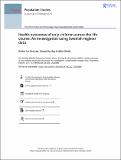Files in this item
Health outcomes of only children across the life course : an investigation using Swedish register data
Item metadata
| dc.contributor.author | Keenan, Katherine | |
| dc.contributor.author | Barclay, Kieron | |
| dc.contributor.author | Goisis, Alice | |
| dc.date.accessioned | 2022-02-02T10:30:11Z | |
| dc.date.available | 2022-02-02T10:30:11Z | |
| dc.date.issued | 2022-02-01 | |
| dc.identifier | 277126084 | |
| dc.identifier | 48842b51-6c2a-47d1-b104-c3dab30442b9 | |
| dc.identifier | 000749365000001 | |
| dc.identifier | 85123959515 | |
| dc.identifier.citation | Keenan , K , Barclay , K & Goisis , A 2022 , ' Health outcomes of only children across the life course : an investigation using Swedish register data ' , Population Studies , vol. Latest Articles . https://doi.org/10.1080/00324728.2021.2020886 | en |
| dc.identifier.issn | 0032-4728 | |
| dc.identifier.other | ORCID: /0000-0002-9670-1607/work/107718368 | |
| dc.identifier.uri | https://hdl.handle.net/10023/24787 | |
| dc.description | This work was partially supported by the Carnegie Trust for the Universities of Scotland [RIG008234] awarded to Katherine Keenan and by the Economic and Social Research Council [grant number ES/S002103/1] to Alice Goisis. This work was also supported by the Swedish Research Council (Vetenskapsrådet) via the Swedish Initiative for Research on Microdata in the Social and Medical Sciences (SIMSAM), grant 340-2013-5164. | en |
| dc.description.abstract | Only children (with no full biological siblings) are a growing subgroup in many high-income settings. Previous studies have largely focused on the short-term developmental outcomes of only children, but there is limited evidence on their health outcomes. Using Swedish population register data for cohorts born 1940–75, we compare the health of only children with that of children from multi-child sibling groups, taking into account birth order, family size, and presence of half-siblings. Only children showed lower height and fitness scores, were more likely to be overweight/obese in late adolescence, and experienced higher later-life mortality than those with one or two siblings. However, only children without half-siblings were consistently healthier than those with half-siblings, suggesting that parental disruption confers additional disadvantages. The health disadvantage was attenuated but not fully explained by adjustment for parental characteristics and after using within-family maternal cousin comparison designs. | |
| dc.format.extent | 20 | |
| dc.format.extent | 1187104 | |
| dc.language.iso | eng | |
| dc.relation.ispartof | Population Studies | en |
| dc.subject | Life course | en |
| dc.subject | Health | en |
| dc.subject | Mortality | en |
| dc.subject | Family size | en |
| dc.subject | Only child | en |
| dc.subject | Sibling | en |
| dc.subject | Family complexity | en |
| dc.subject | Sweden | en |
| dc.subject | Register data | en |
| dc.subject | RJ101 Child Health. Child health services | en |
| dc.subject | HQ The family. Marriage. Woman | en |
| dc.subject | 3rd-DAS | en |
| dc.subject.lcc | RJ101 | en |
| dc.subject.lcc | HQ | en |
| dc.title | Health outcomes of only children across the life course : an investigation using Swedish register data | en |
| dc.type | Journal article | en |
| dc.contributor.sponsor | Carnegie Trust | en |
| dc.contributor.institution | University of St Andrews. Geographies of Sustainability, Society, Inequalities and Possibilities | en |
| dc.contributor.institution | University of St Andrews. Population and Health Research | en |
| dc.contributor.institution | University of St Andrews. School of Geography & Sustainable Development | en |
| dc.identifier.doi | https://doi.org/10.1080/00324728.2021.2020886 | |
| dc.description.status | Peer reviewed | en |
| dc.identifier.url | https://www.tandfonline.com/doi/full/10.1080/00324728.2021.2020886?scroll=top&needAccess=true#supplemental-material-section | en |
| dc.identifier.grantnumber | RIG008234 | en |
This item appears in the following Collection(s)
Items in the St Andrews Research Repository are protected by copyright, with all rights reserved, unless otherwise indicated.

